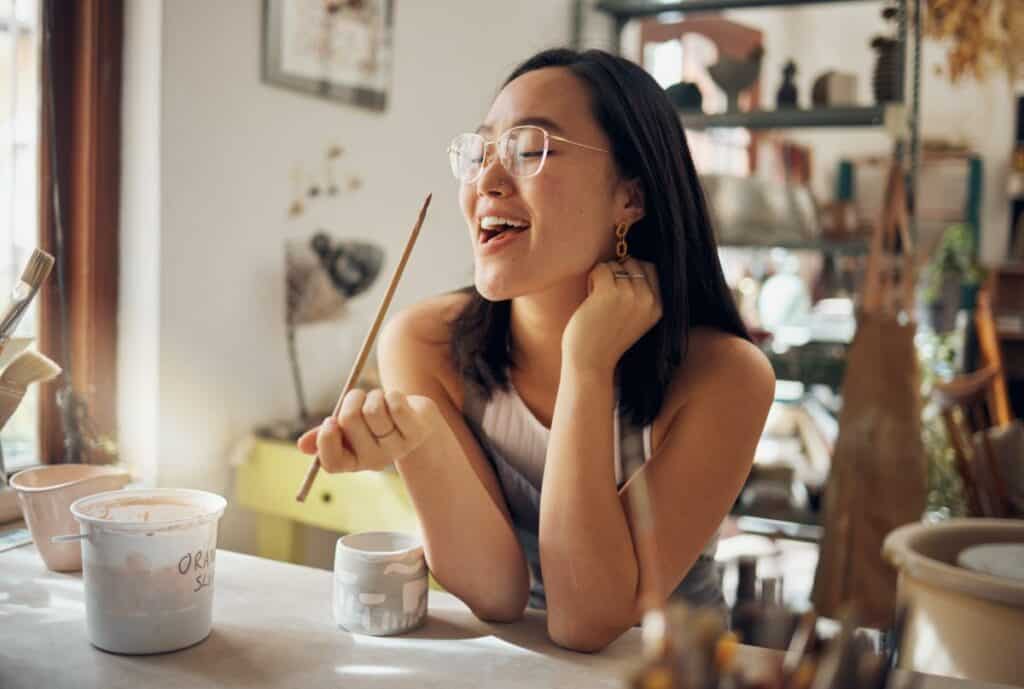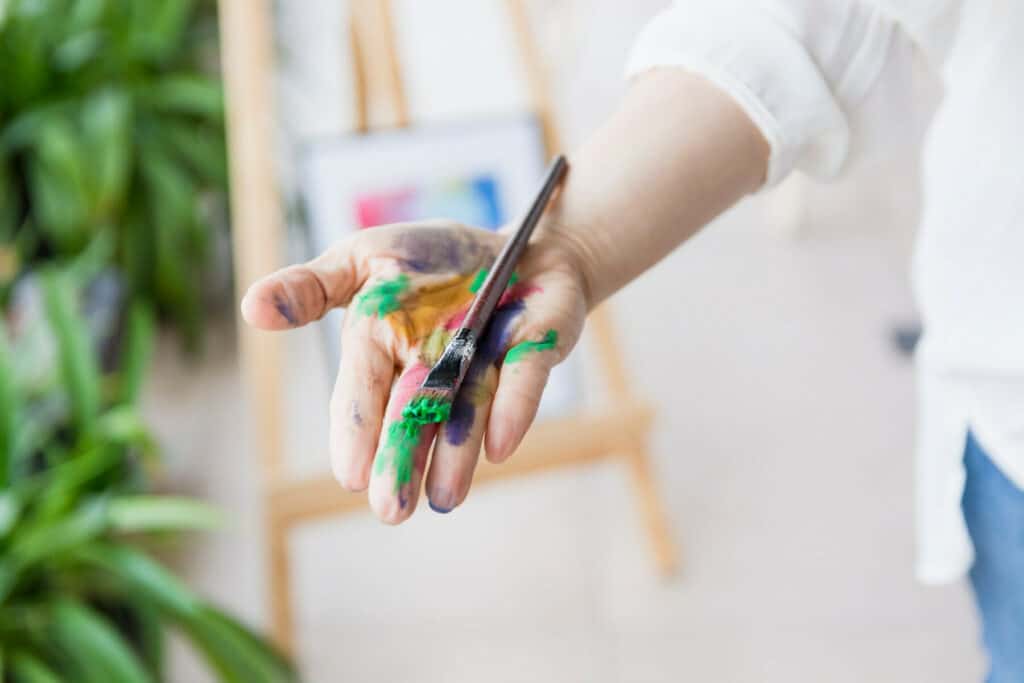Have you ever felt overwhelmed by emotions or stress and struggled to find a way to articulate your feelings? Art therapy for adults might be the answer you’ve been searching for.
Dive into the world of art therapy for adults and discover its benefits, including emotional expression, stress relief, self-awareness, and personal growth.
Get ready to unleash your creativity and embark on a journey toward self-discovery.
The Power of Art Therapy for Adults

Art therapy is a form of psychotherapy that utilizes creative processes to help individuals to:
Explore their emotions
Develop self-awareness
Cope with stress
Improve overall well-being
This therapeutic approach treats various mental disorders and psychological distress, such as Post-Traumatic Stress Disorder (PTSD).
Let’s delve deeper into the benefits of art therapy for adults.
Emotional Expression
Art therapy offers an alternative to verbal communication by allowing individuals to express their emotions creatively.
This form of emotional expression, known as expressive arts therapy, can be particularly beneficial for those who struggle to articulate their feelings.
By engaging in creative activities, adults can process intense emotions and trauma and better understand their emotional state.
For example, finger painting can be a powerful tool for emotional expression, as it allows individuals to:
Create visual representations of their feelings without the need for words
Experience a tactile sensation that can help overcome emotional stress
Relieve emotional tension
Develop a deeper connection with themselves
Stress Relief
Art therapy activities can help reduce stress and promote relaxation, contributing to overall well-being.
Mindful drawing or painting, for instance, involves intuitively creating abstract representations of stressors in response to the prompt’ pressure. This activity can be conducted individually or in a group setting, helping adults cope with stress by focusing on the present moment and their creative process.
In addition to mindful drawing or painting, other art therapy techniques, such as Zentangle® drawing, can also relieve stress. Zentangle® drawing is a method that allows lines and shapes to emerge, reducing stress and promoting relaxation.
These stress-relieving techniques can help adults improve their mental health and increase their mood.
Self-Awareness

Self-awareness is a crucial aspect of personal growth and development. It helps individuals make more informed decisions, communicate more efficiently, and identify their strengths and weaknesses.
Art therapy encourages self-awareness by allowing individuals to express their thoughts, feelings, and experiences creatively.
For instance, self-portraiture in art therapy can help adults gain insight into their emotions, thoughts, and behaviors by examining their artwork.
This process of self-discovery can lead to improved decision-making, better relationships, and a deeper understanding of their self-image, emotions, and experiences.
Personal Growth
Personal growth is the process of cultivating oneself over time, both mentally and emotionally.
Engaging in art therapy can provide individuals with the following:
A deeper understanding of their emotions
The ability to create new coping strategies
Greater self-awareness and personal growth
A more contented life
Better relationships
Increased focus and productivity
Heightened motivation
By expressing themselves creatively, adults can experience these benefits and continue on their journey of personal growth.
For example, mask-making is a creative activity used in art therapy to express various roles people assume in relationships, life situations, and personal strengths.
By exploring these different aspects of their identity, individuals can foster personal growth and better understand themselves and others.
7 Individual Art Therapy Exercises for Adults
A variety of art therapy techniques are available for adults, each offering unique benefits and opportunities for self-expression.
Let’s explore how these techniques can contribute to emotional expression, self-awareness, and personal growth.
1. Drawing and Painting

Engaging in artistic activities such as intuitive drawing and painting serves as a powerful means of expression, allowing individuals to convey emotions and delve into personal experiences.
Participating in this activities has been linked to effective emotion management and trauma processing. The holistic impact encompasses improvements in the overall quality of life, a reduction in symptoms of depression, anxiety, and stress, enhanced communication skills, increased concentration, and a bolstered sense of self-esteem.
These creative practices provide a therapeutic outlet that transcends verbal limitations, making them valuable tools in promoting mental well-being and personal growth.
2. Sculpting

Engaging in sculpting activities serves as a dynamic and therapeutic means for individuals to translate their emotions, thoughts, and experiences into tangible creations.
This creative process not only encourages self-awareness and emotional expression but also offers a tactile and sensory experience, fostering a deeper connection with one’s feelings.
By molding and shaping the clay, individuals can explore their inner world, making it a valuable tool in facilitating emotional exploration and self-expression.
3. Collage

Participating in collage activities involves combining diverse materials and images, offering a creative avenue for exploring themes, emotions, and personal experiences.
This versatile approach proves particularly beneficial for individuals who may feel uneasy with traditional art forms, providing them with greater freedom to express themselves and tap into their creativity.
Specifically, the “collage of emotions” activity serves as a valuable tool for adults seeking to visually represent their feelings using an array of images. This process not only encourages self-expression but also allows individuals to create a visual narrative that captures the complexity and depth of their emotional landscape.
4. Mixed Media

This technique encompases a diverse range of materials and methods to facilitate creative expression, offering individuals a therapeutic outlet that extends beyond traditional forms.
The combination of painting and collage techniques within art therapy presents a unique opportunity for individuals to explore and articulate their emotions.
This integrative approach fosters self-awareness and emotional expression, empowering individuals to convey their inner experiences through a combination of visual elements and creative processes.
5. Journaling and Art Journaling

Journaling and art journaling in art therapy provide a safe space for individuals to express their thoughts, feelings, and experiences through words and images.
This process can help adults understand their emotions and facilitate a deeper connection to their desires, ambitions, and objectives.
Expressive journal writing is a powerful tool for self-expression. It can be done with various mediums, such as:
Words
Drawings
Sketches
Collages
Photos
These mediums represent emotions, thoughts, events, memories, aspirations, and inner strengths.
By engaging in this practice, adults can better understand themselves and their emotions, ultimately leading to greater self-awareness and personal growth.
6. Mindful Drawing or Painting

Mindful drawing or painting encourages individuals to focus on the present moment and their creative process, promoting relaxation and self-awareness.
This technique can help adults to:
Process their emotions
Gain a deeper understanding of their experiences
Achieve greater self-awareness
Experience personal growth
For example, an individual might engage in mindful drawing or painting by creating an abstract representation of their emotions in response to a particular experience or prompt.
By focusing on the process and their present emotions, participants can gain insight into their inner world and develop a deeper connection with themselves.
7. Vision Boards

Vision boards in art therapy help adults visualize their goals, aspirations, and values, fostering motivation and personal growth.
By creating a visual representation of their desired future, adults can better understand their objectives and develop a greater sense of purpose and direction in their lives.
For example, an individual might create a vision board representing their career aspirations, personal relationships, and desired lifestyle.
By regularly revisiting and updating their vision board, adults can focus on their goals and aspirations, ultimately leading to greater motivation and personal growth.
3 Group Art Therapy Activities for Adults
Group art therapy activities can provide a supportive and collaborative environment for adults, promoting social interaction and shared creative expression.
Some group activities include collaborative murals, art-based icebreakers, and themed art projects.
Let’s take a closer look at these activities and their benefits.
1. Collaborative Mural

Collaborative murals in group art therapy sessions encourage teamwork, communication, and shared creative expression.
By working together on a large-scale artwork, participants can connect, develop new perspectives, and foster a sense of belonging within the group.
For example, adults might work together to create a mural representing their hopes and dreams. Through collaboration, individuals can learn about the experiences and emotions of others, leading to greater empathy and understanding within the group.
2. Art-Based Icebreakers

Art-based icebreakers can help participants feel more comfortable and connected in group art therapy sessions, promoting a supportive environment.
These activities often involve creative tasks that encourage self-expression and foster a sense of camaraderie among participants.
For example, an art-based icebreaker might involve each participant creating a small art piece representing something about themselves.
Once completed, the group can share their creations, allowing participants to learn more about one another and build connections. This process helps establish a trusting and supportive atmosphere within the group.
3. Themed Art Projects

Themed art projects in group settings allow individuals to explore common experiences and emotions, fostering empathy and understanding among participants.
By providing a prompt or theme for the group to work on collectively, participants can engage in shared creative expression and develop a deeper connection with one another.
For example, a themed art project might involve participants creating a collage representing their experiences with a particular emotion, such as grief or joy. By sharing their artwork with the group, participants can gain insight into the experiences of others and develop a greater sense of empathy.
Finding an Art Therapist
Finding a certified art therapist can be essential in engaging in art therapy.
With resources available to locate professionals and understand what to expect in art therapy sessions, you can ensure that you receive the support and guidance necessary to experience the full benefits of this therapeutic approach.
Locating a Certified Art Therapist
A certified art therapist can be located through professional directories and organizations, such as the American Art Therapy Association and Find-a-therapist.com ensuring the therapist has the qualifications and experience.
A certified art therapist must possess the following:
A master’s degree in art therapy or a related field
Completed 24 credits of art therapy coursework
Fulfilled an art therapy internship
Passed the Art Therapy Credentials Board exam.
By finding a certified art therapist, you can ensure that your therapist has the appropriate education, training, and experience to guide you through the art therapy process.
This can help you get the most out of your art therapy sessions and experience the full range of benefits this approach offers.
What to Expect in Art Therapy Sessions

Art therapy services typically involve creative activities and discussion, with the therapist guiding the individual through self-exploration and emotional expression.
Some art therapy ideas include activities such as:
Drawing and painting
Sculpting
Collage
Mixed media
The specific activities chosen will depend on the individual’s needs and preferences.
The therapist’s role in art therapy sessions is to facilitate the individual’s self-exploration and emotional expression process, helping them gain insight into their emotions, thoughts, and experiences.
By engaging in art therapy sessions with a qualified therapist, adults can experience the full range of benefits this therapeutic approach offers.
Summary
Art therapy offers a powerful avenue for self-expression, self-awareness, and personal growth. Individuals can explore their emotions, manage stress, and develop greater self-esteem through various techniques.
Art therapy provides a safe and supportive environment for adults to embark on self-discovery, whether in a group setting or individual sessions. If you’re considering art therapy, take the first step by finding a certified art therapist and begin to unlock the potential that lies within your creative expression.
Frequently Asked Questions
Can art therapy be used for adults?
Art therapy has been used to treat patients of all ages, including adults, with various mental health concerns such as stress/anxiety and behavioral problems.
What are the types of art therapy?
Art Therapy utilizes various forms of creative expression, such as painting, drawing, collage, sculpture, music, and creative writing, for therapeutic purposes.
What activities are done in art therapy?
Art therapy encourages clients to express their inner world using various creative forms, such as drawing, painting, music, role-play, poetry, and more. Clients are empowered to explore emotions through creative expression and self-expression.
What mental health issues can art therapy help with?
Art therapy has been known to help with anxiety, depression, stress, trauma, and addiction, offering individuals a safe space to express their emotions through art-making.






